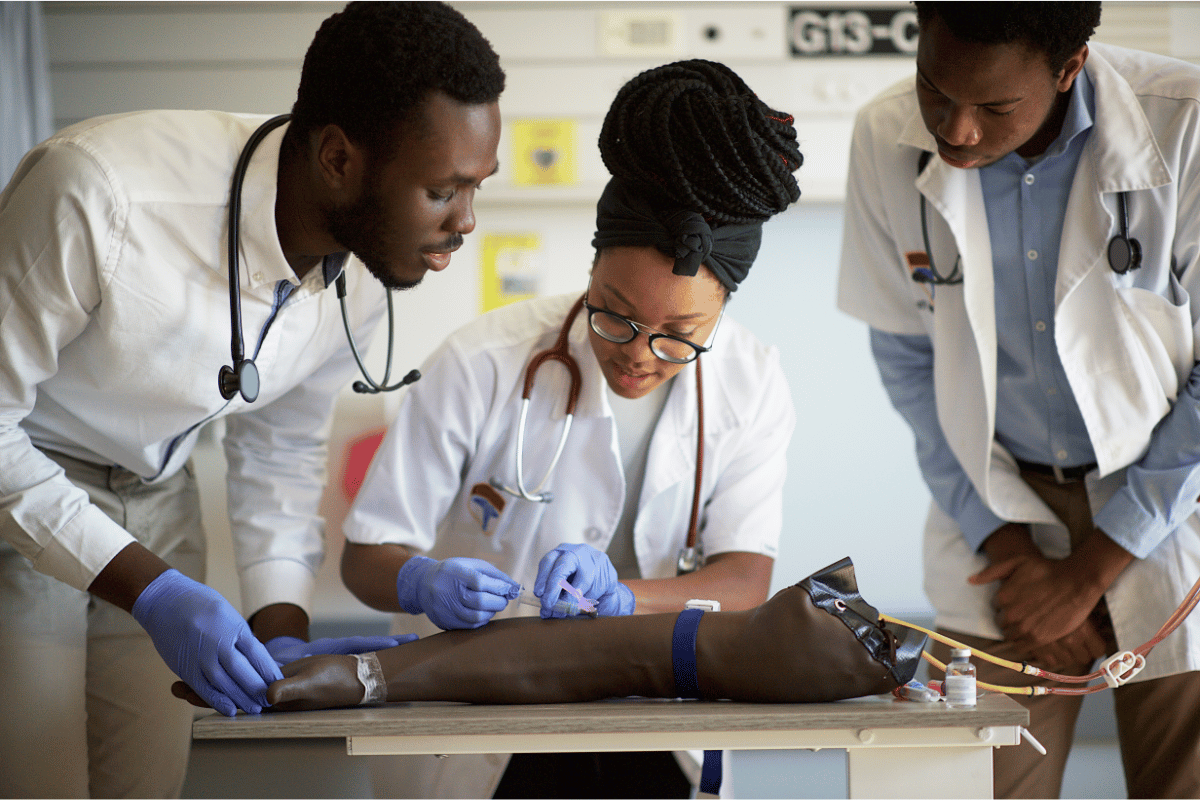A Guide to Phlebotomy
Phlebotomy is the practice of drawing blood from patients for various medical purposes, including diagnostic testing, transfusions, and research. It is a vital skill in healthcare, as blood samples are essential for diagnosing a wide range of medical conditions. Phlebotomists are trained professionals who specialize in this procedure and ensure the safety and comfort of patients during the process. This guide will provide a detailed overview of phlebotomy, including its role in healthcare, techniques, education and certification requirements, and best practices.
1. What is Phlebotomy?
Phlebotomy involves the process of making an incision in a vein (venipuncture) to collect blood for laboratory testing, transfusions, or donation. The procedure must be done with precision to ensure the collection of the required amount of blood while minimizing discomfort to the patient.
Blood samples are critical for diagnosing illnesses, monitoring patient health, and detecting diseases, making phlebotomy an essential practice in healthcare settings like hospitals, clinics, diagnostic laboratories, and blood donation centers.
2. Role of a Phlebotomist
A phlebotomist is a healthcare professional specifically trained to draw blood from patients. Their responsibilities include:
- Verifying patient information.
- Preparing the patient for blood collection.
- Choosing the appropriate venipuncture site.
- Collecting blood samples using safe and hygienic methods.
- Labeling and transporting samples to the laboratory.
- Maintaining accurate patient records.
- Assuring patient safety and comfort during and after the procedure.
Phlebotomists must adhere to strict protocols to minimize the risk of infection, contamination, and complications like hematoma.
3. Phlebotomy Procedures
Phlebotomy can involve various techniques, depending on the patient’s age, condition, and the purpose of the blood collection. The three most common methods are:
A. Venipuncture
The most common method, venipuncture involves inserting a needle into a vein, usually in the arm. This method is used for collecting multiple samples or larger volumes of blood.
B. Fingerstick
A fingerstick involves pricking the fingertip with a small needle to obtain capillary blood. This method is commonly used for glucose testing or when only a small blood sample is needed.
C. Heelstick
This method is often used for infants, particularly newborns. A small prick is made on the heel to collect capillary blood.
4. Phlebotomy Equipment
Phlebotomy requires specialized tools to ensure that the blood collection is efficient and safe. Essential phlebotomy equipment includes:
- Needles: Used for venipuncture, available in various gauges.
- Vacutainer tubes: Blood collection tubes with colored caps indicating the type of additive inside.
- Tourniquet: A device to temporarily restrict blood flow to make veins more visible.
- Alcohol wipes: Used to disinfect the puncture site.
- Gauze and Bandages: To stop bleeding and protect the site after the procedure.
- Gloves: Worn for infection control.
- Lancets: Small needles used for fingerstick or heelstick procedures.
5. Phlebotomy Training and Certification
Becoming a certified phlebotomist typically requires:
- Completion of a Phlebotomy Training Program: Programs are available at vocational schools, community colleges, and hospitals. Training includes both classroom instruction and hands-on clinical experience.
- Certification: While certification is not mandatory in every country, it is often recommended for job prospects. In the U.S., organizations like the National Healthcareer Association (NHA), American Society for Clinical Pathology (ASCP), and American Medical Technologists (AMT) offer phlebotomy certification.
Certification exams usually assess a candidate’s knowledge of blood collection procedures, patient care, and safety protocols.
6. Phlebotomy Techniques and Best Practices
Effective phlebotomy relies on skill, precision, and attention to detail. Key techniques and best practices include:
- Proper Patient Identification: Always verify patient identity using two identifiers (e.g., name and date of birth).
- Choosing the Right Venipuncture Site: The median cubital vein in the arm is the most common site. Avoid areas with scars, rashes, or infections.
- Angle of Insertion: For venipuncture, the needle should be inserted at a 15-30 degree angle.
- Patient Comfort: Explain the procedure and reassure nervous patients to reduce anxiety.
- Proper Disposal: Use sharps containers to dispose of needles immediately after use.
7. Safety and Hygiene in Phlebotomy
Strict safety protocols are critical in phlebotomy to prevent the transmission of infections. Important safety and hygiene practices include:
- Wearing Gloves: Gloves should be worn at all times during the procedure and changed between patients.
- Hand Hygiene: Wash hands before and after patient contact.
- Using Sterile Equipment: All equipment should be sterile, and disposable items like needles should never be reused.
- Safe Needle Handling: Never recap needles, and dispose of them immediately in a designated sharps container.
- Proper Disinfection: The puncture site should be cleaned with alcohol or an antiseptic wipe before inserting the needle.
8. Common Challenges in Phlebotomy
Phlebotomy can present certain challenges, including:
- Difficult Veins: Some patients may have small or hard-to-find veins, making blood collection challenging. In such cases, using a smaller needle or trying alternative sites may help.
- Patient Anxiety: Many patients have a fear of needles or blood. A calm demeanor and clear communication can help alleviate anxiety.
- Hematomas: If blood leaks into the surrounding tissue, a hematoma may form. Applying proper pressure to the puncture site after the procedure reduces the risk.
9. Patient Interaction and Care
Phlebotomists must prioritize patient care and comfort. This involves:
- Clear Communication: Explain the process in simple terms, especially for anxious or nervous patients.
- Monitoring for Reactions: Some patients may feel lightheaded or faint during or after the procedure. In these cases, phlebotomists should offer support, such as having the patient lie down or providing water.
- Post-Procedural Care: Ensure that patients leave with appropriate instructions, such as keeping the bandage on for a few hours and avoiding heavy lifting with the punctured arm.
10. Career Opportunities in Phlebotomy
Phlebotomy is a growing field with career opportunities in various healthcare settings:
- Hospitals: Phlebotomists play a critical role in patient care, assisting doctors with diagnostics.
- Diagnostic Laboratories: Phlebotomists are often employed to collect blood samples for lab testing.
- Blood Donation Centers: Phlebotomists assist in the blood donation process, ensuring donors are safe and comfortable.
- Mobile Phlebotomy Services: Some phlebotomists work in mobile units, visiting patients at home or in community clinics.
Phlebotomy can also serve as a stepping stone for other healthcare careers, such as nursing or medical laboratory technology.
Conclusion
Phlebotomy is a vital component of modern healthcare, enabling accurate diagnosis and treatment through blood collection. Skilled phlebotomists play a crucial role in ensuring the safety, comfort, and well-being of patients. With proper training, certification, and adherence to best practices, phlebotomists can build successful careers in a variety of healthcare environments. For those interested in healthcare but unsure of where to start, phlebotomy offers an accessible entry point with a direct impact on patient care.




